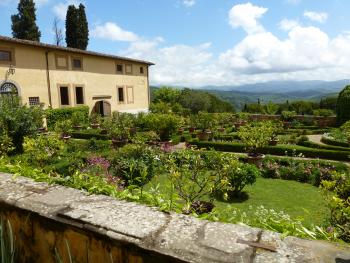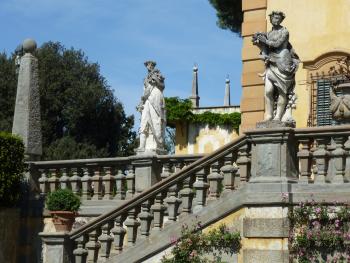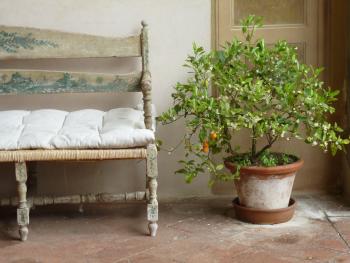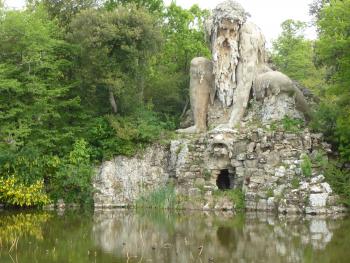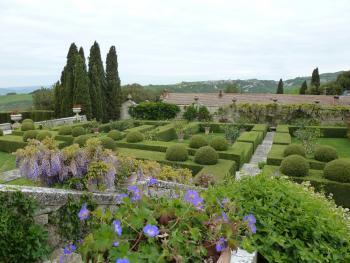Exploring the elegant gardens of Tuscany
This article appears on page 6 of the August 2019 issue.
I’m not a big planner. Many of my life experiences have been the result of my opening the door each time opportunity knocked.
After earning my college degree, I took a 3-month “temp” position at a publishing office in Sacramento to bridge the gap between graduation and figuring out what it was I was going to do next. Twenty-five years later, I’m still at ITN, my life enriched by the travels I’ve been blessed to have experienced as part of my job.
So when a planned “work” trip to Sicily in May of this year was canceled, I simply wondered what else the Universe might have in store for me. It seems she thought I was due for a whole lot of breathtakingly beautiful vistas.
Changing gears
Since I had already booked my flight to Italy, I began looking at what might fit into my scheduled time away. Martin Randall Travel, a company I had enjoyed traveling with just over a decade before (see “Exploring Spain’s Extremadura,” Aug. ’08, pg. 6), kindly offered me the chance to join one of their tours; I just had to choose one.
I barely got past the tour title “Tuscan Gardens” before I’d made my choice, and I began rearranging the rest of my journey to make my participation possible.
After an overnight near London’s Heathrow Airport, I took the included short flight to Pisa, where I met Tour Manager Charlotte Howlett-Jones along with the 13 other members of my group and the tour’s chosen lecturer.
One of the qualities of a Martin Randall tour is that each features an expert speaker who not only delivers scheduled lectures during the tour but accompanies the group on each day’s outings, enhancing, on site, the travelers’ understanding of the places they are visiting.
The lecturer for this trip, author and professor Dr. Katie Campbell, was personable, enthusiastic and always willing to share her wealth of knowledge about the gardens we visited, the families who’d owned them throughout history and the designers whose plans we could see realized before us.
The gardens
From Pisa, we headed by coach to Fiesole, a quiet hilltop town that sits 5 kilometers above the city of Florence. Just a few minutes’ drive from our hotel was the first garden on our itinerary, located at Villa Gamberaia in the town of Settignano.
As I would soon discover was true of most of the gardens we’d visit, from the street, you’d never know what lay behind the walls that surrounded the villa. Only a long alley lined by deep-green cypress trees and a glimpse of the Tuscan-yellow paint covering the walls of the villa were visible through the entry gate.
But beyond the gate, flourishes of pink azaleas; potted trees filled with bright-yellow lemons; cascades of purple wisteria; dark-leaved laurels, and impeccably trimmed boxwood hedges lining shimmering pools of water comprised the separate “rooms” of this 18th-century garden.
Equally as stunning were the views over Florence and the Arno Valley below. It was a wonderful start!
We would visit a total of 13 gardens over the course of our 6-day tour, and it was just about the perfect number. While tours focused on a single subject can sometimes result in oversaturation before reaching the end, I thought this tour was well paced. It had a suitable amount of free time to allow independent exploration of other area sites and included a nice mix of garden styles to keep things interesting.
Though I might have skipped one location — Castello de Celsa — because of a longish bus ride and, in comparison to what we’d seen previously on our tour, a slightly underwhelming garden, there were two gardens that, for me, were highlights.
Impressive design
While the walk down the steep street leading to it was a little hard on my knees (and the walk back up afterward illustrated just how out of shape I am), the garden at Villa Le Balze in Fiesole was absolutely charming.
Designed for American philosopher Charles Augustus Strong by British architect and garden designer Cecil Pinsent and his friend Geoffrey Scott, this compact garden is creatively laid out along a long, narrow plot. The series of enclosed garden spaces, including a more formal orange garden, a rustic grotto and a lower terrace garden overlooked by a rose-covered pergola, lead the visitor from one space to the next, offering a peek at what’s to come without revealing the entire scene.
In contrast to the more manageable scale of Le Balze, La Foce, also designed by Pinsent, covers an enormous amount of land and offers open, sweeping views of the surrounding Tuscan hillside. Of all the gardens visited, this was my absolute favorite.
Until taking this tour, I had not realized the extent to which Anglo-American influence could be found in Tuscany. Reminders of the expats who, lured by the art, architecture and beauty of the land in and around Florence, chose to make Tuscany their home in the 18th, 19th and early 20th centuries could clearly be seen in many of the villas and gardens we visited.
La Foce, once a hospice for those traveling the pilgrimage road between France and Rome, was purchased by Iris Origo, daughter of a wealthy American and a British aristocrat, and her husband, Antonio, in 1924.
Iris (who had grown up at the Villa Medici in Fiesole, also featured on our tour) and Antonio spent a major part of their lives turning the barren, clay-covered land of the surrounding area into a fertile landscape that looks like it has always been there — complete with the Strada di Valoresi, the winding, cypress-lined road that has become an iconic symbol of Tuscany.
From the wisteria-covered walkway that runs along the length of the garden to the severely clipped boxwood hedges of the lower terrace, there was beauty everywhere I looked. Enormous pink peony blossoms, pretty potted lemon trees, lines of lavender irises, bubbling fountains, stone pillars and cool marble benches: together, it was the perfect blend of Italian and English garden design.
The accommodations
We stayed in two hotels on this tour, and both were well selected. Our first accommodation, the 4-star Hotel Villa Fiesole, was lovely. The staff was friendly and helpful, my room, featuring an incredible view of the city of Florence, was light and bright, and the location, with a bus stop right outside that allowed easy transport up to the small town of Fiesole or down to the Renaissance treasure of Florence, was perfect.
Our final two nights were spent at Hotel Relais il Chiostro, a former friary located in the achingly adorable town of Pienza. My room was simple but comfortable, but the view from my window of a patchwork of green rolling hills was wonderful!
Pienza is definitely a tourist town, though one glance at its quaint streets lined with 15th-century buildings (including a number of shops selling delicious Pecorino cheese) makes the high number of visitors easy to understand.
I would recommend a visit to the 13th-century church of San Francesco, located next door to il Chiostro. Small and rustic, it still contains remnants of 14th-century frescoes depicting the life of St. Francis. I visited in the evening and it was nearly empty.
The food
No trip to Italy is complete without indulging in its incredible cuisine, and this tour was no exception. We had a number of included meals on our journey, and a few were certainly standouts.
Ristorante Degli Etruschi in Fiesole was memorable for a few reasons. The first was the steep road we had to climb to get there, though a car was arranged for those who felt they couldn’t make the trek. (Of course, I’m stubborn, so I put myself through the torture instead of taking the ride.) Once we reached our destination, we were greeted by a jovial staff and some incredible food. The pear-and-pecorino-filled pasta course was my favorite.
At Villa Poggio Torselli in San Casciano, the bruschetta, cheese, local honey, cured meats and fresh garden vegetables were yummy, but it was the ambiance that made our lunch there memorable for me. In the former carriage hall, right off the beautiful gardens we had just explored, we enjoyed a family-style lunch served with a flight of wines produced by the estate.
Finally, I certainly didn’t leave hungry after our meal at the hotel restaurant in Pienza. I liked that the pre-trip information sent by Martin Randall included the proposed menus for our included meals, and I was intrigued by the description of the starter here, which included pecorino liquido and polvere d’olio. Liquid cheese and powdered olive oil?! How could they get away with that in this land of pure ingredients?
Well, I don’t know that I can truly explain it, and I certainly couldn’t reproduce it, but I sure enjoyed eating it!
The details
Martin Randall Travel is based in London, but they now have an office in Washington, DC (800/988-6168, www.martinrandall.com). My May 6-11 “Tuscan Gardens” tour was priced at £2,380 ($2,997) per person, double occupancy (£2,280, land only), or £2,750, single.
All tours (outside of England) include round-trip airfare from London (though you can opt for land only), transportation by coach (ours was a comfortable Mercedes van with skilled drivers), all meals listed in the itinerary (for me, that was breakfast daily plus two lunches and four dinners, including wine) and all gratuities.
Covering destinations in the UK, Europe, North Africa, the Middle East, Asia and the Americas, the company offers a variety of tours focused on art, architecture, music, archaeology, history, gardens or gastronomy. A number of one-day guided tours in London (around £200 each) are also available — a great way to fill a gap if you have some time between destinations or tours.
I’ve started using London as my hub for Europe, flying directly into Heathrow from Seattle a day or so ahead of a scheduled visit to Italy, Germany or beyond. The round-trip price is usually around $700-$800, with a flight from there to another major city in Europe costing only a few hundred dollars. Also, an overnight in London helps me get over any jet lag before heading out to explore.
My love for Italy might make me a bit biased, but I can’t really think of any negatives to share about this tour. Everything went smoothly from beginning to end, the tour wonderfully managed by our very gracious tour manager, Charlotte.
I would caution that a good deal of walking is involved, often on uneven surfaces and, yes, up and down some steep hills, so it is not the best selection for anyone with mobility issues.
I do wish I’d had the time to read about the history of each garden before visiting in order to have had a fuller experience (the pre-tour materials included recommended readings), but that didn’t stop me from enjoying six days of being surrounded by the beauty of Tuscany.

